Adolescent idiopathic scoliosis
- Overview
- Theory
- Diagnosis
- Management
- Follow up
- Resources
Treatment algorithm
Please note that formulations/routes and doses may differ between drug names and brands, drug formularies, or locations. Treatment recommendations are specific to patient groups: see disclaimer
screening scoliometer measurement <5° or coronal Cobb angle measurement of ≤10°
regular exercise
The patient should be advised to maintain a regular fitness routine, specifically toward developing improved core strength and conditioning.
observational monitoring
Treatment recommended for ALL patients in selected patient group
If the patient or family identify worsening postural asymmetry or the patient develops symptoms to suggest the presence of another underlying cause for the spinal deformity, observational monitoring with follow-up standing PA and lateral scoliosis x-rays should be undertaken at 4- to 12-month intervals (depending on the estimated rate of growth and remaining growth potential at the time of evaluation).
standing coronal Cobb angle measurement of 11° to 20°
observational monitoring
Follow-up standing PA and lateral scoliosis x-rays should be undertaken at 4- to 12-month intervals (depending on the estimated rate of growth and remaining growth potential at the time of evaluation).
regular exercise
Treatment recommended for ALL patients in selected patient group
The patient should be advised to maintain a regular fitness routine, specifically toward developing improved core strength and conditioning.
standing coronal Cobb angle measurement of 21° to 45°
bracing
Many brace options are available, and the specific type of orthotic used varies from surgeon to surgeon and country to country. Braces commonly used in the US are the Boston and Rosenberger braces and the Charleston bending brace.
Several brace-wearing schedules exist, ranging from 23 hours per day to nighttime-only bracing. The International Scientific Society on Scoliosis Orthopaedic and Rehabilitation Treatment (SOSORT) consensus supports the use of an 18-hour-per-day bracing schedule.[31]Negrini S, Donzelli S, Aulisa AG, et al. 2016 SOSORT guidelines: orthopaedic and rehabilitation treatment of idiopathic scoliosis during growth. Scoliosis Spinal Disord. 2018;13:3. https://www.doi.org/10.1186/s13013-017-0145-8 http://www.ncbi.nlm.nih.gov/pubmed/29435499?tool=bestpractice.com Other organizations have also attempted to develop “Consensus of Care” statements and guidelines in an effort to standardize scoliosis brace treatment protocols.[31]Negrini S, Donzelli S, Aulisa AG, et al. 2016 SOSORT guidelines: orthopaedic and rehabilitation treatment of idiopathic scoliosis during growth. Scoliosis Spinal Disord. 2018;13:3. https://www.doi.org/10.1186/s13013-017-0145-8 http://www.ncbi.nlm.nih.gov/pubmed/29435499?tool=bestpractice.com [57]Kotwicki T, Durmala J, Czaprowski D, et al. Conservative management of idiopathic scoliosis: guidelines based on SOSORT 2006 Consensus. Ortop Traumatol Rehabil. 2009 Sep-Oct;11(5):379-95. http://www.ncbi.nlm.nih.gov/pubmed/19920281?tool=bestpractice.com [58]Roye BD, Simhon ME, Matsumoto H, et al. Establishing consensus on the best practice guidelines for the use of bracing in adolescent idiopathic scoliosis. Spine Deform. 2020 Aug;8(4):597-604. http://www.ncbi.nlm.nih.gov/pubmed/32026441?tool=bestpractice.com
The goal of brace treatment is to prevent curve progression until skeletal maturity, at which time the risk of further curve progression significantly reduces.
Data from the BrAIST (Bracing in Adolescent Idiopathic Scoliosis Trial) trial have shown a significantly lower risk of curve progression in patients with AIS who wore a brace compared with those who did not.[45]Weinstein SL, Dolan LA, Wright JG, et al. Effects of bracing in adolescents with idiopathic scoliosis. N Engl J Med. 2013 Oct 17;369(16):1512-21.
https://www.doi.org/10.1056/NEJMoa1307337
http://www.ncbi.nlm.nih.gov/pubmed/24047455?tool=bestpractice.com
One Cochrane review concluded that all of the included studies consistently showed that bracing in AIS prevented curve progression, including 7 separate studies that included a total of 662 participants.[59]Negrini S, Minozzi S, Bettany-Saltikov J, et al. Braces for idiopathic scoliosis in adolescents. Cochrane Database Syst Rev. 2015 Jun 18;(6):CD006850.
https://onlinelibrary.wiley.com/doi/10.1002/14651858.CD006850.pub3/full
http://www.ncbi.nlm.nih.gov/pubmed/26086959?tool=bestpractice.com
[Figure caption and citation for the preceding image starts]: Typical thoracic-lumbar-sacral orthosis (TLSO) scoliosis braceWeinstein SL, et al. Adolescent idiopathic scoliosis. Lancet. 2008;371:1527-1537. Used with permission [Citation ends].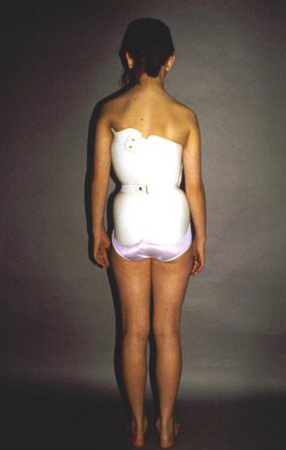
regular exercise
Treatment recommended for ALL patients in selected patient group
The patient should be advised to maintain a regular fitness routine, specifically toward developing improved core strength and conditioning.
standing coronal Cobb angle measurement of >45°
surgical spinal arthrodesis
Spinal arthrodesis with instrumentation aims to achieve maximal deformity correction, improve appearance with trunk balancing, stop continued curve progression, and reduce short- and long-term complications related to the spinal deformity.[60]Dickson JH, Mirkovic S, Noble PC, et al. Results of operative treatment of idiopathic scoliosis in adults. J Bone Joint Surg Am. 1995 Apr;77(4):513-23. http://www.ncbi.nlm.nih.gov/pubmed/7713967?tool=bestpractice.com
The choice of surgical approach and instrumentation technique is dictated by the characteristics of the deformity (e.g., location of the curve apex), degree of spinal flexibility, and surgeon preference.[60]Dickson JH, Mirkovic S, Noble PC, et al. Results of operative treatment of idiopathic scoliosis in adults. J Bone Joint Surg Am. 1995 Apr;77(4):513-23.
http://www.ncbi.nlm.nih.gov/pubmed/7713967?tool=bestpractice.com
Most deformities are treated with a posterior approach, although some surgeons use an anterior approach with the belief that the deformity can be corrected with a lower number of fused levels.[65]Muschik MT, Kimmich H, Demmel T. Comparison of anterior and posterior double-rod instrumentation for thoracic idiopathic scoliosis: results of 141 patients. Eur Spine J. 2006 Jul;15(7):1128-38.
http://www.ncbi.nlm.nih.gov/pubmed/16470398?tool=bestpractice.com
[66]Turi M, Johnston CE 2nd, Richards BS. Anterior correction of idiopathic scoliosis using TSRH instrumentation. Spine. 1993 Mar 15;18(4):417-22.
http://www.ncbi.nlm.nih.gov/pubmed/8469999?tool=bestpractice.com
[67]Newton PO. The use of video-assisted thoracoscopic surgery in the treatment of adolescent idiopathic scoliosis. Instr Course Lect. 2005;54:551-8.
http://www.ncbi.nlm.nih.gov/pubmed/15948480?tool=bestpractice.com
[68]Newton PO, Faro FD, Gollogly S, et al. Results of preoperative pulmonary function testing of adolescents with idiopathic scoliosis. A study of six hundred and thirty-one patients. J Bone Joint Surg Am. 2005 Sep;87(9):1937-46.
http://www.ncbi.nlm.nih.gov/pubmed/16140807?tool=bestpractice.com
[69]Newton PO, Marks M, Faro F, et al. Use of video-assisted thoracoscopic surgery to reduce perioperative morbidity in scoliosis surgery. Spine. 2003 Oct 15;28(20):S249-54.
http://www.ncbi.nlm.nih.gov/pubmed/14560200?tool=bestpractice.com
[70]Newton PO, Parent S, Marks M, et al. Prospective evaluation of 50 consecutive scoliosis patients surgically treated with thoracoscopic anterior instrumentation. Spine. 2005 Sep 1;30(17 Suppl):S100-9.
http://www.ncbi.nlm.nih.gov/pubmed/16138057?tool=bestpractice.com
[71]Newton PO, Wenger DR, Mubarak SJ, et al. Anterior release and fusion in pediatric spinal deformity. A comparison of early outcome and cost of thoracoscopic and open thoracotomy approaches. Spine. 1997 Jun 15;22(12):1398-406.
http://www.ncbi.nlm.nih.gov/pubmed/9201845?tool=bestpractice.com
[72]Newton PO, White KK, Faro F, et al. The success of thoracoscopic anterior fusion in a consecutive series of 112 pediatric spinal deformity cases. Spine. 2005 Feb 15;30(4):392-8.
http://www.ncbi.nlm.nih.gov/pubmed/15706335?tool=bestpractice.com
[73]Reddi V, Clarke DV Jr, Arlet V. Anterior thoracoscopic instrumentation in adolescent idiopathic scoliosis: a systematic review. Spine (Phila Pa 1976). 2008 Aug 15;33(18):1986-94.
http://www.ncbi.nlm.nih.gov/pubmed/18665023?tool=bestpractice.com
However, this approach has a higher incidence of implant failure and pseudarthrosis, and has been associated with a risk of pulmonary complications secondary to the need for "single lung" anesthesia during the procedure.[74]Betz RR, Harms J, Clements DH 3rd, et al. Comparison of anterior and posterior instrumentation for correction of adolescent thoracic idiopathic scoliosis. Spine. 1999 Feb 1;24(3):225-39.
http://www.ncbi.nlm.nih.gov/pubmed/10025017?tool=bestpractice.com
[75]Lenke LG. Anterior endoscopic discectomy and fusion for adolescent idiopathic scoliosis. Spine. 2003 Aug 1;28(15 Suppl):S36-43.
http://www.ncbi.nlm.nih.gov/pubmed/12897472?tool=bestpractice.com
[76]Lowe TG, Alongi PR, Smith DA, et al. Anterior single rod instrumentation for thoracolumbar adolescent idiopathic scoliosis with and without the use of structural interbody support. Spine. 2003 Aug 1;28(15 Suppl):S36-43.
http://www.ncbi.nlm.nih.gov/pubmed/14520036?tool=bestpractice.com
[Figure caption and citation for the preceding image starts]: Posteroanterior scoliosis radiograph of a 13-year-old girl with a 49° right thoracic curvature with apex at the T9-T10 disc spaceFrom the collection of Stuart Weinstein, MD, University of Iowa; used with permission [Citation ends].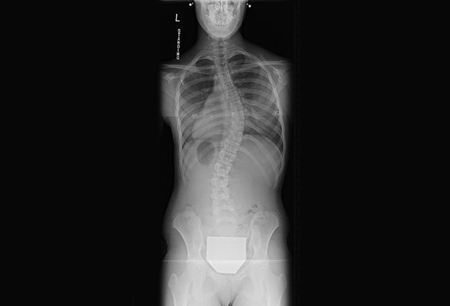 [Figure caption and citation for the preceding image starts]: Lateral scoliosis radiograph of a 13-year-old girl with a 49° right thoracic curvatureFrom the collection of Stuart Weinstein, MD, University of Iowa; used with permission [Citation ends].
[Figure caption and citation for the preceding image starts]: Lateral scoliosis radiograph of a 13-year-old girl with a 49° right thoracic curvatureFrom the collection of Stuart Weinstein, MD, University of Iowa; used with permission [Citation ends].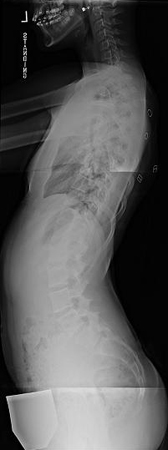 [Figure caption and citation for the preceding image starts]: Thirteen-year-old girl post-posterior spinal instrumentation and fusion for progressive scoliosisFrom the collection of Stuart Weinstein, MD, University of Iowa; used with permission [Citation ends].
[Figure caption and citation for the preceding image starts]: Thirteen-year-old girl post-posterior spinal instrumentation and fusion for progressive scoliosisFrom the collection of Stuart Weinstein, MD, University of Iowa; used with permission [Citation ends].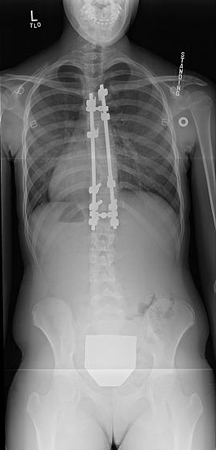 [Figure caption and citation for the preceding image starts]: Thirteen-year-old girl post-posterior spinal instrumentation and fusion for progressive scoliosisFrom the collection of Stuart Weinstein, MD, University of Iowa; used with permission [Citation ends].
[Figure caption and citation for the preceding image starts]: Thirteen-year-old girl post-posterior spinal instrumentation and fusion for progressive scoliosisFrom the collection of Stuart Weinstein, MD, University of Iowa; used with permission [Citation ends].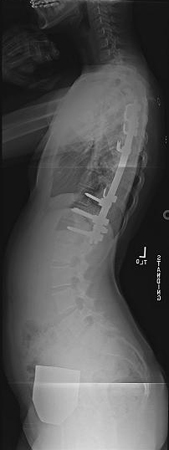
regular exercise
Treatment recommended for ALL patients in selected patient group
The patient should be advised to maintain a regular fitness routine, specifically toward developing improved core strength and conditioning.

Choose a patient group to see our recommendations
Please note that formulations/routes and doses may differ between drug names and brands, drug formularies, or locations. Treatment recommendations are specific to patient groups. See disclaimer
Use of this content is subject to our disclaimer